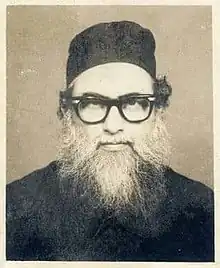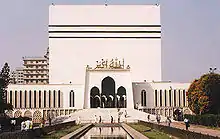Nesaruddin Ahmad | |
|---|---|
নেছারউদ্দীন আহমদ | |
 Nesaruddin Ahmad, Pir of Sarsina | |
| Personal | |
| Born | 1873 |
| Died | January 31, 1952 (aged 78–79) |
| Resting place | Sarsina Darbar Sharif graveyard |
| Religion | Islam |
| Children | Abu Zafar Mohammad Saleh |
| Denomination | Sunni |
| Jurisprudence | Hanafi |
| Creed | Maturidi |
| Education | Calcutta Alia Madrasa Hooghly Madrasah |
| Tariqa | Furfura (Chishti-Qadri-Naqshbandi (Mujaddidi)) |
| Arabic name | |
| Personal (Ism) | Nithār ad-Dīn Aḥmad نثار الدين أحمد |
| Patronymic (Nasab) | ibn Ṣadr ad-Dīn ibn Ẓahīr ad-Dīn بن صدر الدين بن ظهير الدين |
| Epithet (Laqab) | Shôrśinar Pīr Ṣāḥeb Qiblah শর্ষিণার পীর সাহেব কেবলা[1] |
| Toponymic (Nisba) | Ākhūnd آخوند al-Barīsālī البريسالي |
| Muslim leader | |
| Disciple of | Mohammad Abu Bakr Siddique |
Influenced by | |
| 1st Pir of Sarsina | |
| Succeeded by | Abu Zafar Mohammad Saleh |
| Naib-e-Sadar of Jamiat-e-Ulama Bangla o Assam[3] | |
| Islam in Bangladesh |
|---|
 |
Nesaruddin Ahmad (Bengali: নেছারউদ্দীন আহমদ; 1873 – 31 January 1952) was a Bengali Islamic scholar, spiritual reformer, educationist and writer. He was the main disciple of Furfura Sharif's Mohammad Abu Bakr Siddique in eastern Bengal.[4] Ahmad was the inaugural Pir of Sarsina (Bengali: শর্ষিণার পীর), having founded the Sarsina Darbar Sharif and Darussunnat Kamil Madrasa in 1915,[5] one of the largest Islamic institutions in South Bengal and the first major alia madrasah after Calcutta.[6] Ahmad was among the leading Islamic leaders in colonial Barisal,[7][8] and his influence extended across Bengal.[9] The Nesarabad Upazila of Bangladesh has been named after him.[10]
Early life and family
Ahmad was born in 1873 to a Bengali Muslim family of Akhunds in the village of Magura, Firozpur, then located under the Backergunge District of the Bengal Presidency. When he was twelve years old, his father, Sadruddin Akhund, decided to set off for the Hajj pilgrimage to Arabia. Akhund was a murid of Haji Saizuddin Miah of Bahadurpur. Before leaving, he married Ahmad to Sahera Khatun, the daughter of his neighbour Daliluddin Shiqdar. Ahmad's father died in Mecca, being buried in Jannat al-Mu'alla, and so Ahmad was raised by his mother, Zohra Begum, and paternal grandfather.[11] His paternal grandfather, Zahiruddin Akhund, was a munshi and disciple of Haji Shariatullah of the Faraizi movement based in Mathbaria where he had a sizeable following.[12]
In 1905, Ahmad married the daughter of Abdul Wafi Chowdhury from Kushla, Gopalganj.[13]
Education
Ahmad started his primary education at the local school in his village. His mother then sent him to Madaripur as there were no notable madrasas in the greater Barisal region. Ahmad completed his dakhil qualification from Madaripur Primary Islamia Madrasa, and then completed his alim from Madrasah-i-Hammadiyyah in Armanitola, Dhaka. After that, he enrolled at the Calcutta Alia Madrasa and subsequently at Hooghly Madrasa where he completed his further religious studies. Whilst at Hooghly, Ahmad pledged bay'ah to Mohammad Abu Bakr Siddique of Furfura Sharif in 1895.[14]
Career
After receiving khilafat (spiritual succession) from his murshid Mohammad Abu Bakr Siddique, Ahmad returned to his village.[15] He planned to leave for Hajj but was affected by pox. As soon as he recovered in 1901, Ahmad boarded the ship to Arabia along with his family and nephew Abdur Rashid. His wife, Sahera Khatun, and son, Shah Muhammad Muzahar, died in Mecca. After returning to Bengal, Ahmad dedicated himself to propagating Islamic teachings. In 1905, he built a small library in his village which became the Qiratiyyah Madrasah in 1913. In 1918, he decided to transform the library into a madrasa modelled from Calcutta Alia Madrasa. Ahmad named the madrasa "Sarsina Darussunnat Kamil Alia Madrasa".[16] From then on, the village of Magura got the name of Sarsina. He appointed Moulvi Mirza Ali of Idilpur as its head. Ahmad donated all of his property to act as the madrasa's waqf in 1934. With the assistance of Prime Minister A. K. Fazlul Huq, the madrasa became the second title madrasa of Bengal after Calcutta in 1938.[17]
Ahmad gave his support to Maniruzzaman Islamabadi's plans in establishing a dedicated Islamic university in Chittagong.[18]
Political involvement
Ahmad was a supporter of the Pakistan Movement. He maintained good relations with Shamsul Haque Faridpuri, who belonged to the Deobandi movement.[19] He favoured Faridpuri over Sheikh Mujibur Rahman in the Muslim League local elections.[20] Ahmad sent a telegram to Muhammad Ali Jinnah requesting that he admits A. K. Fazlul Huq back into the All-India Muslim League to ensure the League's victory in Barisal.[9] In 1946, Ahmad organised the All-India Ulama Conference held at Mohammad Ali Park, Calcutta. At the conference, Ahmad co-signed a petition with Abdul Hai Siddique in pamphlet form addressing Bengali Muslim voters in favour of Pakistan.[21] During the 1947 Sylhet referendum, he sent an eight-member team (including Azizur Rahman Qaid Nesarabadi) to Sylhet under the leadership of his son Abu Zafar Mohammad Saleh.[22][23]
After the independence of Pakistan, Ahmad focused on Islamic values within the government. An outline of 22 points was formulated at the All-Parties Ulama Conference in Sarsina.[11] Ahmad presided the East Bengal Horooful Quran Conference in Dacca in August 1951, which supported Urdu as the national language of Pakistan and Bengali in Arabic script as the provincial language.[24][25]
Bibliography
Ahmad was written many books relating to Islam.[26] He wrote articles for the fortnightly Tabligh magazine. Among them are:
- মোছলেম রত্নহার (Moslem Ratnahar)
- ফুরফুরা পীর সাহেবের অছিয়তনামা (Furfura Pir Saheber Asiyatnama)
- তালিমে মারেফত (Talim-e-Marefat)
- তাহকীকে বর্জখ (Tahqiq-e-Barzakh)
- খেলাফত আন্দোলন পদ্ধতি (Khelafat Andolan Paddhati)
- সমাজ উন্নতি (Samaj Unnati)
- মাওলানার উক্তি (Mawlanar Ukti)
- ছোবহেছাদেক (Subh-e-Sadeq)
- রদ্দে বদগুমান (Radd-e-Badguman)
- মজহব ও তকলীদ (Mazhab O Taqlid)
- দাড়ি গোঁফ সমস্যা ও হক কথা (Dari Gof Samasya O Haq Katha)
- নুরুন হেদায়েত ও বেদাত ফকিরের ধোকা ভঞ্জন (Nurun Hedayet O Bedat Faqirer Dhoka Bhanjan)
- ফতোয়ায়ে ছিদ্দিকী (Fatwa-e-Siddiqi)
- তরিকুল ইসলাম (Tariqul Islam)
- নারী ও পরদা (Nari O Parda)
- জুমার অকাট্য দলীল প্রভৃতি (Jumar Akatya Dalil Prabhriti)
- দাড়ি ও ধুমপান (Dari O Dhumpan)
- হজরত বায়েজীদ বোস্তামী (Hazrat Bayazid Bostami)
- الحقيقة المعرفة الربانية (Al-Haqiqah al-Marifah al-Rabbaniyyah)
Death and legacy
Ahmad died on 31 January 1952 and was buried at the Sarsina Darbar Sharif.[11] He was succeeded by his son, Abu Zafar Mohammad Saleh, as the Pir of Sarsina. His other son, Azizur Rahman Qaid, founded the Nesarabad Darbar Sharif.[6] In 1985, the Swarupkati Upazila was renamed to Nesarabad Upazila in honour of Ahmad.[10] The annual gathering at Sarsina Darbar Sharif, which was started in 1891, continues to take place.[27]
See also
Further reading
- "Official Website". Sarsina Darbar Sharif.
References
- ↑ Siddiq, Shah Mohammad (1961). তাবিজের কেতাব (in Bengali). Sarshina Library.
- ↑ Al-Hanafi, Saifullah (November 2013). মিথ্যাবাদীদের মুখোশ উন্মোচন (in Bengali). Sylhet, Bangladesh: Shah Waliullah Foundation. pp. 177–193.
- ↑ Ruhul Amin, Mohammad (2014). অতি জরুরী মছলা-মাছায়েল (in Bengali) (4 ed.). Basirhat, North 24 Parganas, West Bengal: Nabanur Press. pp. 48–51.
{{cite book}}: CS1 maint: location (link) - ↑ Ray, Aniruddha (2004). "আধুনিক ভারত" [Modern India]. ইতিহাস অনুসন্ধান (in Bengali). pp. 408–409.
- ↑ The Muslim World League Journal. Muslim World League. 24: 43. June 1996.
{{cite journal}}: Missing or empty|title=(help) - 1 2 Islam, Muhammad Nazrul; Islam, Muhammad Saidul (2020). Islam and Democracy in South Asia: The Case of Bangladesh. Springer International Publishing. p. 202. ISBN 9783030429096.
- ↑ Sharif, Ahmed. "ইংরেজ আমলে মুসলিম-মানসের পরিচয়-সূত্র". সাহিত্য ও সংস্কৃতি চিন্তা (in Bengali). p. 269.
- ↑ বরিশাল বিভাগ প্রতিষ্ঠা উপলক্ষে স্মারক সংকলন. Barisal Division Welfare Association. 1 January 1993. pp. 59, 81.
- 1 2 Zaidi, Z. H. (1993). Quaid-i-Azam Mohammad Ali Jinnah Papers: The verdict for Pakistan, 1 August 1945-31 March 1946. National Archives of Pakistan. p. 582.
- 1 2 Parvez, Masud (2012). "Nesarabad (Swarupkati) Upazila". In Sirajul Islam; Miah, Sajahan; Khanam, Mahfuza; Ahmed, Sabbir (eds.). Banglapedia: the National Encyclopedia of Bangladesh (Online ed.). Dhaka, Bangladesh: Banglapedia Trust, Asiatic Society of Bangladesh. ISBN 984-32-0576-6. OCLC 52727562. OL 30677644M. Retrieved 10 January 2024.
- 1 2 3 Ahmed, Siraj Uddin (2010). "নেছারউদ্দীন আহমদ (রহ.), শাহ সূফী, (শর্শিনার পির সাহেব)". বরিশাল বিভাগের ইতিহাস [History of Barisal Division] (in Bengali). Vol. 2. Dhaka: Bhaskar Prakashani.
- ↑ শাহ সুফী নেছারুদ্দীন আহমদ (রহঃ) একটি জীবন, একটি আদর্শ (PDF) (in Bengali). Sarsina Darbar Sharif.
- ↑ Ahmed, Siraj Uddin, ed. (1993). বরিশাল বিভাগ পরিচিতি. Dhaka: Greater Bakerganj-Patuakhali Society. pp. 36–37.
- ↑ "ছারছীনা দরবার শরীফের প্রতিষ্ঠাতা পীরে কামেল শাহ সূফী নেছারুদ্দীন আহমদ (র:) এর জীবনী". Teachers.gov.bd (in Bengali).
- ↑ Ruhul Amin, Muhammad (2005). ফুরফুরা শরীফের ইতিহাস ও হজরত আবুবকর সিদ্দীকী (রহঃ) এর বিস্তারিত জীবনী (in Bengali) (5 ed.). Basirhat, North 24 Parganas, West Bengal: Nabanur Press. p. 52.
{{cite book}}: CS1 maint: location (link) - ↑ "আল্লামা নেছারুদ্দীন রহমাতুল্লাহি আলাইহির জীবন ও কর্ম". Jago News 24 (in Bengali). Retrieved 2021-06-04.
- ↑ "ইসলামী আদর্শ বিস্তারে ছারছীনার মরহুম পীর ছাহেবদ্বয়ের অবদান অবিস্মরণীয়-ছারছীনার পীর ছাহেব". Daily Inqilab (in Bengali). Retrieved 2021-06-04.
- ↑ Hossain, Imran (1993). বাঙালি মসুলিম বুদ্ধিজীবী: চিন্তা ও কর্ম, ১৯০৫-১৯৪৭ (in Bengali). Bangla Academy. p. 244. ISBN 9789840728886.
- ↑ Abdur Razzaq, Muhammad (24 October 2021). মুজাহিদে আযম সমাজ সংস্কারক আল্লামা শামসুল হক ফরিদপুরী (ছদর সাহেব রহঃ)-এর জীবনী (in Bengali). Bangla Bazar, Dhaka: Al-Ashraf Prakashani. pp. 96, 118.
- ↑ Mujibur Rahman, Sheikh. The Unfinished Memoirs. p. 256.
- ↑ Mahmud, Abdul Ghani (1993). জীবন্ত অতীত: স্মৃতি কথা (in Bengali). Mahmud Prakashani. p. 15.
- ↑ al-Kumillai, Muhammad Hifzur Rahman (2018). كتاب البدور المضية في تراجم الحنفية (in Arabic). Cairo, Egypt: Dar al-Salih.
- ↑ Chaudhury, Rathindrakanta Ghataka (1988). ঝরাপাতা (in Bengali). Barna Bichitra. p. 82.
- ↑ Umar, Badruddin, ed. (1985). ভাষা আন্দোলন প্রসঙ্গ: কতিপয় দলিল. Vol. 2. Bangla Academy. p. 101.
- ↑ Bhowmik, Satya N. (1993). Die Sprachenpolitik der Muslim-League-Regierung und die Entstehung der Bengali-Sprachbewegung in Ostbengalen, 1947-1956 (in German). F. Steiner. p. 134. ISBN 9783515063838.
- ↑ Ishaq, Muhammad, ed. (1981). Bangladesh District Gazetteers. Bangladesh Government Press. p. 247.
- ↑ Abdur Rahman, Muhammad (30 November 2020). "Peace and prosperity of the Muslim nation is not possible without Sahih Amal and Aqeedah: Pir Sahib of Sarsina". The Muslim Times.